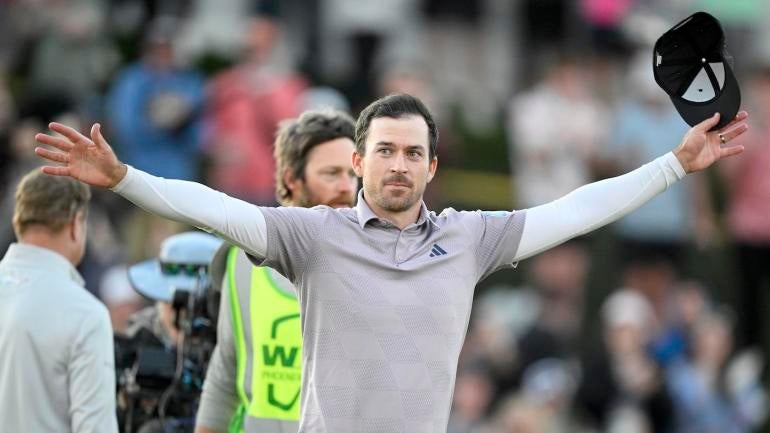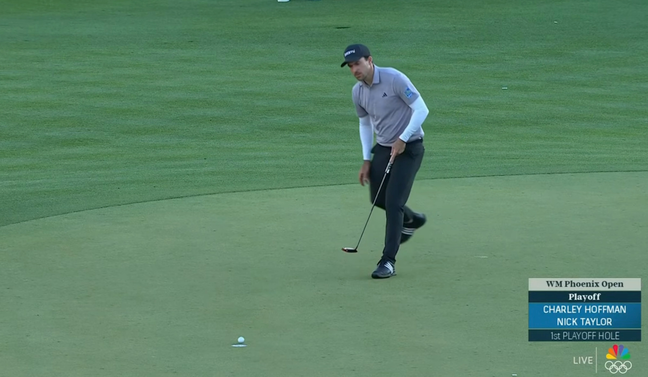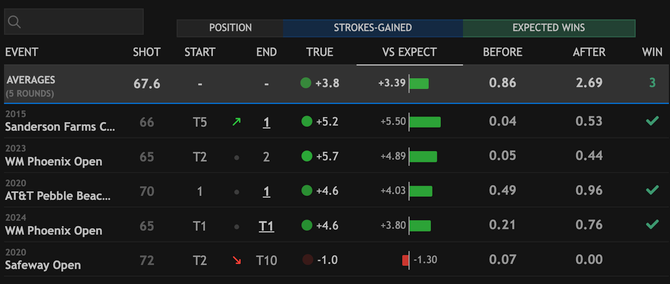
There are walked-in putts, and then there are walked-in putts. You may have experienced the former in a casual round of golf, but you have almost certainly not partaken in the latter like Nick Taylor did Sunday evening at the 2024 WM Phoenix Open when he beat Charley Hoffman in a two-hole playoff. Taylor made birdie at five of his last six holes, including three straight on the 18th (one in regulation, two in a playoff).
It was that first playoff hole that made me rethink the entire Nick Taylor Experience.
Taylor is a good player. He has been for a long time. You don't win four times across 10 years on the PGA Tour -- Sanderson Farms Championship, Pebble Beach Pro Am, Canadian Open, Phoenix Open -- like he has without being a good player. He generally exists inside the top 100 in the Data Golf rankings, and while he doesn't excel in any particular skill, Taylor doesn't necessarily have any holes either. His single worst statistical year in a given category came in 2014 when he lost 0.34 strokes per round to fields with his putter. In other words, he has a relatively high floor.
High-floor guys are generally players who just kind of hang around. They don't do anything spectacular, they just keep their PGA Tour cards for a long time and make sure the direct deposit numbers haven't changed. (In Taylor's case, as a Canadian, he's likely ensuring the exchange rate continues to work in his favor, too.)
Taylor has certainly done that. He's made $16.5 million across 260 PGA Tour events, earnings of more than $63,000 per week of golf played. He has been consistent and steady. In four different years, he's earned between $830,000 and $900,000. In a volatile financial world like pro golf, that kind of sustained success is aspirational.
Taylor might also be kind of a badass.
Following a lipped-in 3 at the 18th in regulation -- to get to 21 under and into the playoff with Hoffman -- Taylor hit his approach on the first playoff hole (again, the par-4 18th) to 14 feet. His putt never left the center of the cup, and he tried to simultaneously walk in a $1.5 million check while also stepping on Hoffman's throat with his left foot.

Hoffman made his 7-footer -- after seeing what Taylor did, that was remarkable -- but Taylor kept coming. The Canadian made an 11-footer on the second playoff hole for the win. His celebration was less aggressive than it was on the first playoff hole yet still tremendous by golf standards.
NICK TAYLOR IS CLUTCH! pic.twitter.com/UdJpm2JwZ7
— PGA TOUR (@PGATOUR) February 12, 2024
Throughout all of this, I couldn't help but consider Taylor's closing ability. Last June, just before the U.S. Open, he became the first Canadian to win his national open since 1954. How did he do it? By making birdie at the 71st hole from 17 feet and birdie at the 72nd hole from 11 feet to get into a playoff with Tommy Fleetwood. You probably know the rest, but if you don't, Taylor made a 72-foot eagle putt on the fourth playoff hole to defeat Fleetwood and get the third Tour win of his career.
The evidence is not just anecdotal, it's also empirical. As Data Golf pointed out Sunday, Taylor has proven time and again that he shows up when he's near the lead entering the final rounds. It happened last year at the Phoenix Open when he shot a 65 in the same group as Jon Rahm and Scottie Scheffler (unfortunately for him, Scheffler also shot 65 to win), and it happened this year when Taylor again shot 65 in the final round with three birdies across his last four holes of regulation.
"Last year was a huge stepping stone in my career to play with Rahm and Scottie in the final group," Taylor said Sunday. "[They were] one, two in the world, and really, stand[ing on] my own gave me a lot of confidence, so to ride that the rest of the year and win my national open in the fashion that I did was incredible.
"It's been fun to be in those moments. Last year, I drew a lot on for the Canadian Open, and I've drawn on that for plenty of moments, as well. For whatever reason it is, the later it gets [in a tournament], I just seem to get a little more locked in and zoned in and kind of relish those moments, and it's been a lot of fun."
Taylor has entered the final round of PGA Tour events inside the top five on the leaderboard just five times. His average true strokes gained in those rounds is 3.8 (a ton), and he out-paces his expected strokes gained by a wild margin. He has increased his expected wins from about one (before those final rounds) to nearly three (based on final-round performances).
This is what closing looks like!

There are basically two ways for a golfer to win most professional events: increase your contention rate or hit rate.
Taylor's contention rate is low; he's rarely in the mix opposed to guys like Scheffler and Justin Thomas, whom he beat Sunday at TPC Scottsdale. Only five top fives going into the final round of Tour events over the course of 10 years is not very good.
Taylor's win rate, though? It's off the charts. To win three of those events and finish runner up in another is unusual; it's the sign of somebody who is extremely confident in his game and his abilities.
Not that you couldn't already tell from the way he walked in that putt on the first playoff hole.
Rick Gehman and Kyle Porter recap the 2024 WM Phoenix Open. Follow & listen to The First Cut on Apple Podcasts and Spotify.

















